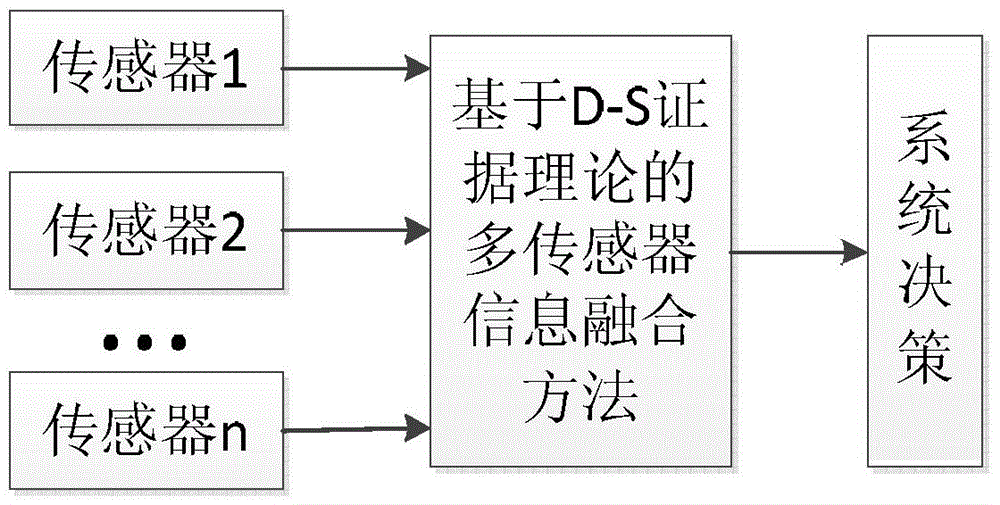D-S evidence theory based multi-sensor information fusion method
A kind of evidence theory and multi-sensor technology, applied in the direction of electrical digital data processing, special data processing applications, instruments, etc., can solve the problems of large amount of calculation, uncertainty of synthesis results, etc., and achieve the effect of reducing the amount of calculation
- Summary
- Abstract
- Description
- Claims
- Application Information
AI Technical Summary
Problems solved by technology
Method used
Image
Examples
specific Embodiment approach 1
[0037] Specific implementation mode one: combine figure 1 and figure 2 Describe this embodiment, the multi-sensor information fusion method based on D-S evidence theory, comprises the following steps:
[0038] Step 1. Acquisition of original evidence:
[0039] Take each sensor source of l sensors (from the perspective of data acquisition, the sensor is called a sensor source) as an evidence source, and obtain l pieces of evidence e i The evidence set E={e i , i=1, 2,...,l}; According to the set identification frame Θ={θ 1 , θ 2 ,...,θ n} put evidence e i Organized as evidence data m i (A), i=1, 2, ..., l;
[0040] Θ={θ 1 , θ 2 ,...,θ n} is a mutually exclusive and complete set of propositions called the identification frame, n is the number of propositions in the identification frame, Indicates the event or object to which the evidence data points;
[0041] Step 2. Extraction and sorting of focal element sets:
[0042] In the evidence set E, all satisfying evid...
specific Embodiment approach 2
[0056] Specific implementation mode two: the fusion weight function w described in step four i (C j ) should meet the following conditions:
[0057] (1) Fusion weight function w i (C j ) should satisfy non-negativity, that is, w i (C j )≥0, j=1,2,...,J;
[0058] (2) Fusion weight function w i (C j ) should satisfy boundedness, that is, w i (C j )≤1, j=1, 2, ..., J;
[0059] (3) Fusion weight function w i (C j ) should embody Proposition C j The degree of certainty for the focal element C in the original evidence j and C q , if C j The degree of certainty is higher than that of focal element C q , then there should be w i (C j )≥w i (C q ), wherein q is the index of focal element counting, and the meaning is the same as j, that is, q=1, 2, ..., J; w i (C q ) for C q Fusion weight function.
[0060] Other steps and parameters are the same as in the first embodiment.
specific Embodiment approach 3
[0061] Specific embodiment three: the fusion weight function w described in step four i (C j )The following conditions:
[0062] when m' i (C j ) = m i (C j ), w i (C j )=1;
[0063] when m i (C j )=0 and m' i (C j )=1,w i (C j )=0.
[0064] Fusion weight function w i (C j ) effectively reflects the reliability of the evidence.
[0065] Other steps and parameters are the same as those in Embodiment 1 or Embodiment 2.
PUM
 Login to View More
Login to View More Abstract
Description
Claims
Application Information
 Login to View More
Login to View More - R&D
- Intellectual Property
- Life Sciences
- Materials
- Tech Scout
- Unparalleled Data Quality
- Higher Quality Content
- 60% Fewer Hallucinations
Browse by: Latest US Patents, China's latest patents, Technical Efficacy Thesaurus, Application Domain, Technology Topic, Popular Technical Reports.
© 2025 PatSnap. All rights reserved.Legal|Privacy policy|Modern Slavery Act Transparency Statement|Sitemap|About US| Contact US: help@patsnap.com



